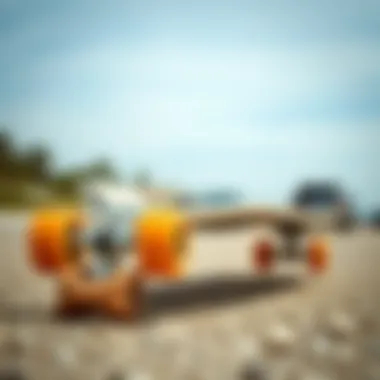Exploring Long Skateboards: Design and Culture


Intro
Long skateboards, often referred to as longboards, are not just a mode of transportation; they are a bridge between the world of skating and the soul of surfing. It’s fascinating how a board with wheels can capture the very essence of wave riding while thriving on solid ground. This article plunges into the deep waters of long skateboards, dissecting their anatomy, functionality, and cultural resonance.
The longboarding scene has shaped not just the thrill-seekers but also a community that breathes and lives for that glide. The boards, crafted from a variety of materials, each bring different characteristics to the riding experience. Often, you’ll hear enthusiasts say that riding a longboard feels like surfing on land, and there’s truth to it. The designs cater to a different set of techniques, compared to traditional skateboards or surfboards. They open doors to a diverse riding style, suited for different skill levels, thus attracting both novices and seasoned riders alike.
As we dive deeper into the art of riding long skateboards, we will explore practical tips for beginners, along with advanced techniques that seasoned riders might find intriguing. So, let's get rolling into the essence of this sport that blends the carefree spirit of surfing with the streets' adrenaline.
Preface to Long Skateboards
Long skateboards, often celebrated for their unique design and versatility, have carved a niche in the minds of surfers, outdoor enthusiasts, and active travelers alike. The essence of longboarding extends beyond mere transportation; it encapsulates a lifestyle deeply woven into the fabric of surf culture. With their extended decks and flexible frames, longboards offer an alternative to traditional skateboards, enabling a smooth ride that mimics the rhythm of surfing. This article aims to spotlight the intricate relationship between long skateboards and surfing culture, analyzing every facet from design innovations to the lifestyle elements that connect these two dynamic worlds.
Definition and Historical Context
To understand long skateboards and their significance, we begin with a clear definition. Longboards are essentially extended versions of traditional skateboards. They can range from 33 to 59 inches in length, making them notably different from conventional boards. Their size provides enhanced stability, which is particularly beneficial for carving and cruising.
Historically, longboards emerged in the late 1950s and early 1960s. Surf culture, already blooming in California, inspired these boards as surfers sought pavement alternatives to ride when the waves were flat. This trend evolved when skateboard enthusiasts embraced longboards, realizing the advantages they offered for cruising. Interestingly, the first longboards often consisted of wooden planks, resembling surfboards more than the modern designs we see today.
Understanding this context is vital not only for appreciating these boards but also for grasping their evolving significance as a recreational tool.
Evolution of the Longboard Design
Over the decades, longboard design has undergone significant transformations, mirroring advancements in technology and shifts in rider preferences. Early models featured a simple, flat wooden deck, which often lacked the sophistication of modern engineering. As time passed, materials and construction methods evolved, paving the way for high-performance boards.
Today, longboards are crafted from a range of materials, including bamboo, plywood, and composite fabrics. This shift isn't just about aesthetics; the materials chosen impact weight, durability, and flex, all crucial for different riding styles.
Moreover, the design of trucks (the components that hold the wheels) has also seen improvements. Modern longboard trucks allow for better turning capabilities and stability, which makes a world of difference when navigating hills or tight curves.
With this sophisticated evolution, longboards have shifted from their humble beginnings to become symbols of freedom and creativity on wheels. For enthusiasts and newcomers alike, understanding the origins and advancements of longboard design enriches the riding experience, ensuring that both novices and experts can appreciate the craftsmanship behind these boards.
Understanding the Longboard Components
Understanding the components of a longboard is pivotal for anyone keen on experiencing the joys of longboarding. Each part contributes uniquely to the overall function and performance of the board, influencing aspects such as ride quality, stability, and comfort. With a proper grasp of how these elements interact, riders can make informed choices, tailoring their setups to fit their personal styles and the terrains they frequent.
Deck Types and Materials
The deck is, without a doubt, the heart of a longboard. This is where riders stand, execute tricks, and experience the true essence of riding. Decks come in various shapes and sizes, including drop-through, top mount, and directional designs. Each type suits different riding styles:
- Drop-through decks provide a lower center of gravity, enhancing stability and ease for downhill riding.
- Top mount boards offer a more traditional feel, ideal for tricks and technical maneuvers.
- Directional shapes cater to focused riding styles, often used in cruising or racing scenarios.
Material choice matters too. While traditional wood remains popular, modern longboard decks are often made from materials like bamboo or fiberglass for added lightness and flexibility. Bamboo, for example, provides a unique bounce and durability, perfect for those longer rides while still being easy on the eyes.
Trucks: Differences that Matter
Trucks connect the wheels to the deck, allowing for stability and smooth turns. Selecting the right trucks can make or break a riding experience. Typically, there are two main types of trucks: standard and precision.
- Standard trucks are adjustable, providing flexibility and a comfortable ride whether you're cruising through the park or going downhill.
- Precision trucks, on the other hand, offer a tighter fit and can be designed for specific activities such as slalom or downhill racing. This snug fit provides more direct control, which may be hard to come by in standard options.
Wider trucks generally allow for better stability, which is critical when speeding down hills. Riders should monitor their truck width in relation to their deck width for optimal balance. A mismatch can lead to a wobbly ride.
Wheels: Size and Shore Durometer
Wheels, perhaps the most noticeable aspect of longboard design, vary widely in size and material configuration. When selecting wheels, both diameter and durometer (a measure of hardness) are crucial.
- Wheels typically range from 65mm to 80mm in diameter. Larger wheels glide over rough surfaces effortlessly, making them the go-to for cruising. However, smaller wheels offer superior control and are often favored in tricks or technical environments.
- Durometer spans from 78A to 101A; softer wheels provide grip and a smoother ride yet wear down faster, while harder wheels slide well and last longer but can feel rougher on bumpy roads.
Choosing the right wheel is akin to picking the right shoe for an occasion. It significantly influences how you interact with your environment and the overall enjoyment you glean from your sessions.
Understanding these components allows enthusiasts to appreciate the underlying design and how each element contributes to the ride. From the deck to the wheels, knowing what makes each part tick can lead to more informed choices and ultimately, a more enjoyable longboarding experience.
Performance: Why Choose Longboards?


When considering the essence of longboards, performance takes center stage. Longboards offer a unique combination of stability, control, and versatility that sets them apart from their shorter counterparts. For those who embark on the road with purpose—be it for transportation or leisure—understanding the performance that longboards can provide is essential in making the right choice.
Longboards possess a longer wheelbase, which significantly enhances stability during rides. This is particularly beneficial for beginners who are still finding their feet. Unlike traditional skateboards, where the risk of wipeouts looms large due to sudden turns and sharp stops, longboards allow for smoother transitions. Riders can feel a sense of confidence while cruising, making them ideal for a relaxed journey down a park pathway or through bustling urban streets.
Moreover, longboards excel in various riding styles. The performance element is not just confined to stability but extends to the exhilarating techniques that can be mastered. Let’s explore what sets longboards apart and why many choose this style for their skating journey.
Stability and Control
When it comes to stability, longboards shine bright. The combination of a wider deck and longer wheelbase provides a solid foundation for riders. It’s akin to a boat on water—a broader frame means less rocking and a steadier glide.
- Wider Deck: This feature ensures that riders have ample space for foot placement, enabling greater balance and confidence.
- Longer Wheelbase: A longer distance between the front and rear wheels translates into reduced risk of tumbling, especially during sharp turns.
- Low Center of Gravity: Many longboards are designed close to the ground, enhancing the sense of security and control that a rider feels while cruising.
For those memories of a shaky ride, longboards might just offer a solution by providing riders with the ability to explore without fear.
Pushing and Carving Techniques
Another characteristic of longboarding is the captivating art of pushing and carving. Riders often find themselves getting lost in the rhythm of it all.
Pushing with a longboard differs significantly from traditional skateboards. With the extra stability, many riders can take advantage of longer strokes, leading to more efficient propulsion. It’s almost like taking a stroll, where small pushes allow the rider to maintain speed without the frantic effort required with shorter boards. This leads to an effortless glide.
Carving, on the other hand, is the delightful dance of cutting through turns. With a longboard, the arcs are smoother and less jarring. Riders can swing from side to side, similar to how a surfer rides a wave, allowing them to chase that thrill of flow without the jitters.
For those interested in perfecting these techniques, practice is key. Sai, a longtime longboarder from California, notes how honing these skills brings not just confidence but also joy. It’s not just about getting from point A to point B; it’s about enjoying every curve and hill along the way.
"Longboarding isn’t just a sport; it is a lifestyle. The feeling of carving through turns is pure joy.” - Sai, longboard enthusiast
Cruising vs. Freeride
Understanding the distinction between cruising and freeride can impact a rider’s experience significantly. Cruising is akin to a leisurely drive along the coast, soaking in the advanced views. In contrast, freeriding involves embracing the wild side—taking risks while navigating obstacles.
- Cruising: Ideal for those looking to enjoy a laid-back ride. It’s less about tricks and more about the experience. Therefore, those who prefer smooth glides and picturesque sceneries will find solace in this approach.
- Freeride: For adrenaline chasers, freeriding offers the thrill of downhill movements, slides, and tricks. Riders push their limits to gain momentum and let loose. The choice of equipment might differ for the optimized performance, providing enhanced grip and flexibility.
In a nutshell, the performance of longboards caters to diverse backgrounds. Whether it’s the stability demanded for serene rides or the age-old thrill of mastering tricks, longboards ensure riders can find their way. Understanding these aspects certainly leads skaters to better appreciate their tool of transportation, shaping not just their riding experience but their connection to the culture surrounding longboarding.
For more insights on the longboarding community and techniques, refer to resources like Wikipedia or discussions on platforms like Reddit.
Ultimately, the decision to choose longboards rests not just on riding style but also on the adventure that each ride brings.
Cultural Impact of Longboarding
Longboarding transcends mere transportation. It encapsulates a lifestyle that blends sport with culture, intimately tying itself to the psyche of those who partake in it. Understanding the cultural impact of longboarding is crucial, particularly in relation to surf culture. Longboarding has not just been a phase; it's a dynamic expression of freedom, creativity, and authenticity.
Longboarding in Surf Culture
Longboarding draws heavily from the vast ocean of surf culture, creating a symbiotic relationship that is both rich and nuanced. The longboard itself mirrors the design and philosophy of surfboards, often seen as a bridge between land and sea. It’s fascinating to see how this connection plays out in everyday life.
Surfers often find themselves transitioning from wave riding to cruising the streets, maintaining that sense of flow and connection with the environment. The aesthetic sensibilities align remarkably, with stylish graphics and eco-friendly materials often echoing the designs found in surfboards. Outfits worn while longboarding are often borrowed from surfing, showcasing vibrant colors and functional styles that prioritize comfort.
Notably, longboarding has reinvigorated a sense of community, akin to that existing in surf towns. Events like the ’Longboard Festival' or ‘Open Streets', where participants ride together, celebrate not just the sport but the culture itself. They're not just gatherings, they are cultural experiences that emphasize the communal ties shared by longboarders and surfers alike.
Community and Events
The longboarding community thrives on shared experiences, and events play a pivotal role in nurturing this vibrant culture. Here, riders from all walks of life converge, united by a passion that goes beyond ride quality and technique.
Events like the California Longboard Championship or the North American Downhill Tour are more than just competitions; they are venues for connecting and sharing. Here's what’s typically at the heart of these gatherings:
- Skill sharing: Riders exchange tips on maneuvers, techniques, or even board maintenance.
- Cultural exchange: It’s a melting pot of backgrounds; some hail from surf cities, while others come from urban areas. Each event sparks discussions about different riding styles and cultural influences.
- Sustainability awareness: Many events now incorporate a sustainability ethos, emphasizing environmentally friendly practices, from waste reduction to the use of sustainable materials in boards and gear.
Interestingly, with social media serving as the modern campfire, community presence is felt year-round. Groups are often organized through platforms like Facebook and Reddit, allowing riders to share their experiences and organize meetups when the weather permits. It’s this sense of being connected, whether in person or virtually, that gives longboarding its pulse, driving its expansion and popularity.
Longboarding is more than just a pastime; it reflects a culture steeped in history and community. It brings forth a dialogue between land and surfing that is unique and ever-evolving, highlighting its deep-seated relevance in today’s outdoor lifestyle.
Environmental Considerations


When discussing long skateboards, it becomes essential to touch on environmental considerations. As outdoor enthusiasts and surf culture fans take to the streets and parks, the impact of our choices can either benefit or harm the planet. Awareness of how longboards are made, where the materials come from, and the overall environmental footprint is becoming increasingly relevant. Addressing these aspects not only influences individual decisions but also shapes the industry toward more sustainable practices.
Sustainable Material Choices
Sustainable material choices play a pivotal role in minimizing harm to the environment. Longboards traditionally use a variety of woods for their decks, such as maple, bamboo, or even recycled materials like plastic composites. Bamboo, for example, is a highly renewable resource, growing much faster than traditional hardwoods. This makes it an attractive option for eco-conscious riders. Furthermore, some manufacturers are opting for reclaimed wood, reducing deforestation and waste.
Here are some sustainable materials to consider in longboard construction:
- Bamboo: Strong and lightweight with a small environmental footprint.
- Maple: Though a common choice, look for sustainably sourced options.
- Recycled plastics: These can reduce waste and repurpose items that would otherwise end up in landfills.
- Natural resins: These can replace synthetic glues that are harmful to both riders and the planet.
Selecting a board made from these materials can significantly lower one’s environmental impact while enjoying the sport.
Minimizing Environmental Impact
Reducing environmental impact extends beyond choosing the right materials. Eco-friendly manufacturing processes are equally important. Manufacturers are now investing in cleaner technologies and practices, from waste reduction to energy efficiency during production. One way to minimize the ecological footprint is through local sourcing. By buying from local artisans or companies, consumers can cut down on transportation emissions, which is a significant contributor to pollution.
Here are some strategies for minimizing environmental impact while enjoying longboarding:
- Choosing Local Brands: Supporting local manufacturers reduces carbon footprints associated with shipping.
- Regular Maintenance: Well-kept boards last longer and reduce the need for frequent replacements.
- Eco-Friendly Products: Use non-toxic cleaning solutions and renewable resources for board upkeep.
- Participating in Clean-Up Events: Many longboarding communities organize events focusing on beautifying local parks and streets. This not only enhances the riding experience but raises awareness about environmental stewardship.
Incorporating these strategies into your longboarding routine can create a positive shift towards a more sustainable lifestyle. Remember, every small step counts, and being mindful of one's choices in longboarding contributes to the broader movement for environmental protection.
"The ability to make positive environmental choices is not just a trend; it's a responsibility we all share."
Educated consumers can shape the longboarding market by prioritizing eco-friendly options and sustainable practices. As the connection between riding and environmental ethics strengthens, the longboarding community can truly align itself with the ethos of surfing, which celebrates not just the sport, but also respect for nature.
Longboarding Techniques
Understanding longboarding techniques is essential for anyone venturing into this thrilling world. It's not just about cruising down the street; it's about mastering the art of balance, control, and movement. Having a firm grasp on these techniques can enhance your riding experience and transport you from novice to proficient with finesse.
Basic Skills for Beginners
When starting on a longboard, focus on honing the fundamental skills. Here’s a rundown of the core abilities you need:
- Balance: This is the foundation of all skating activities. Begin by standing on your board while stationary. Rock gently from heel to toe and find your center of gravity.
- Pushing: To generate speed, learn how to push off effectively with one foot while the other foot remains on the board. You might feel wobbly at first, but practice makes perfect.
- Carving: This involves shifting your weight to turn left or right while gaining speed. Think about it as shifting your hips and knees, almost like dancing with the board.
- Stopping: Learning how to stop safely is crucial. Try the foot brake by dragging your back foot on the ground until you slow down sufficiently.
Master these basics and you’ll be well on your way to enjoying your longboarding adventures. Practice, and soon it will feel like second nature, allowing you to focus on the experience rather than your footing.
Advanced Maneuvers and Tricks
Once you've gotten comfortable on a longboard, it’s time to push the envelope and start tackling some advanced maneuvers. These tricks not only elevate your skills but also tweak your style and impress onlookers. Here are some noteworthy techniques:
- Slide: This is a game-changer for speed control. Put your weight back on the rear trucks and use your front foot to guide the direction of the slide. It takes practice to get the angle just right, but when you do, the sensation is incredibly rewarding.
- Kickturn: A staple for navigating tight corners. Shift weight onto your back foot while lifting the front wheels slightly off the ground, then pivot to change direction. This is particularly useful in urban environments and crowded spaces.
- Bombing Hills: This is for the adrenaline junkies. When tackling steep descents, tuck your knees and lower your body close to the board for better aerodynamics. Make sure to have solid stopping techniques at the ready; it can escalate quickly.
- Freestyle Tricks: Once you're feeling bold, explore various freestyle tricks like the 360-degree spin or the ollie. These require a good understanding of physics, balance, and timing.
Mastering these advanced techniques takes work, but the thrill of nailing that kickturn or executing a flawless slide is worth every minute spent practicing. Remember, safety gear like helmets and pads are vital to keep you protected as you explore these exciting skills.
If skating is like dancing with the board, then longboarding is a full-on concert, with moves that speak volumes about your style and confidence.
Longboarding isn't just a skill but also an art form. By perfecting both the essentials and the advanced moves, you're not just getting better; you're embodying a lifestyle while enjoying the openness of the roads or the flexibility of the parks on your longboard.
Longboarding Destinations
Longboarding is not just a mode of transport; it’s a way to connect with the environment, find thrill in motion, and immerse oneself in diverse landscapes. A well-chosen destination can elevate the riding experience, providing the right blend of challenge and enjoyment. In this section, we will focus on why longboarding destinations matter, highlighting specific spots that cater to both urban enthusiasts and nature lovers.
Urban Spots for Longboarding
Urban environments offer a unique canvas for longboarding, with their bustling streets, sprawling sidewalks, and diverse architecture. Some of the key elements to consider when choosing urban spots include:
- Smooth Surfaces: Think along the lines of an unblemished pavement that lets you glide without interruptions.
- Varied Terrain: Riding through urban landscapes can mean tackling hills, flats, and even the occasional ramp.
- Safety: Urban areas can be crowded; always check for bike lanes or less busy streets to ride with ease.
Some prime urban longboarding spots include:
- San Francisco, California: The steep hills here are not just renowned for their views, but also for the thrill they provide to longboarders. The city streets offer a different kind of excitement that attracts riders looking for adrenaline.
- Melbourne, Australia: Known for its vibrant street art and dedicated skate spaces, Melbourne is a haven for longboarders. The Yarra River paths present beautiful scenes while offering a smooth ride.
- Barcelona, Spain: With its rich architecture and dynamic culture, Barcelona boasts a wide range of spots – from flat roads near the beach to tighter areas in the Gothic Quarter, it's about savoring the ride while soaking up the local vibe.


Nature Trails and Parks
For those who prefer the serenity of open air and natural beauty, longboarding on nature trails and within parks is a refreshing option. Here, riders can embrace peace, away from city chaos. Some considerations for choosing nature-focused spots include:
- Environmental Beauty: Enjoy landscapes, forests, and lakes while you ride.
- Peacefulness: Fewer distractions mean you can focus fully on the ride without stress or hustle.
- Common Wildlife: Spotting local wildlife adds another layer of excitement to your outing.
Optimal nature spots for longboarding typically include:
- The Golden Gate Park, California: Spanning over 1,000 acres, it offers wide paths, winding trails, and an abundance of scenery.
- Ravine Systems in Toronto, Canada: Known for its extensive trail systems, Toronto’s ravines can be a joy for longboarders looking for a quiet escape from urban life.
- Acadia National Park, Maine: Not typically known for longboarding, but the carriage roads offer a unique experience. Riders get to experience nature while gliding through soft trails surrounded by stunning views.
"Longboarding isn’t just about the destination, but how you experience the journey across it.”
Both urban and nature spots offer unparalleled experiences, enabling longboarders to stretch their skills and connect with the world around them. Overall, selecting the right environment can make your longboarding experience not just pleasurable, but truly memorable.
Innovations in Longboard Technology
Innovations in longboard technology have played a pivotal role in shaping the experience longboarders enjoy today. The evolution of materials, designs, and constructions leads to performance that caters to a variety of riders, from beginners to seasoned shredders. Each new feature helps broaden the appeal of longboarding within and beyond the surf culture. Engineers and designers continually push the envelope, seeking ways to enhance the ride while ensuring it remains accessible and exciting for all.
Advancements in Board Design
When talking about advancements in board designs, weight and flexibility often take center stage. Traditional wood decks, while beloved for their aesthetics and feel, are increasingly being paired with composite materials like fiberglass and carbon fiber. These materials allow for thinner, lighter boards that still pack a punch in performance.
For example, the use of drop-through and drop deck designs allows for a lower center of gravity, promoting improved stability and control. Riders can experience enhanced carving and agility while navigating urban landscapes or curving mountain roads. Some models even feature unique shapes, such as pintails or cruisers, which add a layer of personalization based on riding styles.
- Lightweight composites improve maneuverability
- Drop-through designs offer better stability
- Unique shapes address diverse riding preferences
This constant innovation is not just about performance; it also impacts safety. Many companies now utilize anti-slip grip tapes and sophisticated shock absorption systems to shield riders from both sudden stops and turbulent terrains.
Longboarding vs. Traditional Skateboarding
When discussing the realm of skateboarding, the distinction between longboarding and traditional skateboarding emerges as a fundamental topic worth exploring. These two styles, while sharing similarities, also exhibit clear differences in terms of design, riding style, and overall user experience. Understanding these differences can greatly influence a rider's choice, particularly if they are seeking specific advantages that resonate with their lifestyle and preferences.
Key Differences in Riding Styles
Longboarding and traditional skateboarding cater to different riding experiences, which influences how practitioners approach them. Longboards, typically longer and wider than standard skateboards, provide a stable ride that is favored for cruising and carving. This design aspect supports greater stability at high speeds, making longboards excellent for downhill rides or extended journeys on smoother surfaces.
In contrast, traditional skateboards, shorter in length, allow for more aggressive tricks and stunts. Riders who prefer technical riding often opt for skateboards due to their maneuverability, enabling them to execute kickflips and grinds with precision.
Here are some of the key differences in riding styles:
- Stability vs. Maneuverability: Longboards offer a stable platform, while traditional skateboards are designed for quick turns and tricks.
- Speed Control: Longboards excel at maintaining speed over long distances, whereas traditional skateboards are better geared for short bursts and tricks.
- Riding Techniques: Longboarding often involves techniques like carving and pumping, while traditional skateboarding focuses on flips and ollies.
Overall, your riding style may largely dictate which board type best suits your needs, whether you seek serene rides down coastal paths or adrenaline-pumping tricks in urban settings.
Audience and Popularity Trends
The audience engaging in longboarding versus traditional skateboarding has also evolved over time, reflecting the shifting cultural tides surrounding these sports. Longboarding has gained popularity amongst those who value a laid-back, cruising lifestyle, blending elements of surfing and skating with a focus on community and connection with the outdoors.
On the other hand, traditional skateboarding has maintained a robust following within the realm of street culture and sports, appealing to younger enthusiasts seeking the thrill of tricks and style. This demographic often revolves around urban environments where skateparks are prevalent.
As for popularity trends, the rise of social media platforms has amplified the reach of both longboarding and traditional skateboarding communities. Skateboarding either long or traditional can now be seen thriving on platforms like Instagram and TikTok, where users share their experiences with engaging visuals that inspire others.
Notably, longboard brands and traditional skateboard companies have both tapped into these platforms to highlight their unique lifestyles. Here’s a quick snapshot of how these trends manifest:
- Increasing Longboarding Events: Events like Longboard Girls Crew and various downhill races have encouraged participation, significantly growing this community.
- Skateboarding Competitions: The global popularity of skateboarding has soared, with activities like the X Games and Olympic inclusion showcasing traditional skateboarding.
In summary, whether one finds themselves drawn to the rhythmic glide of longboards or the exhilerating challenge of traditional skateboards, the contrasting experiences speak to a broader narrative of personal preference and cultural expression within the skating universe. Both styles attract diverse audiences and foster distinct communities, ultimately contributing to the rich tapestry of skating culture.
Closure: The Future of Long Skateboarding
The world of long skateboarding is at a fascinating crossroads, balancing on the thin line between tradition and innovation. As skate culture continues to intertwine with surfing, their shared values and aesthetics create a vibrant community that is ever-evolving. The future of longboarding not only reflects advances in technology and design but also embodies the cultural significance that underpins every ride.
Longboarding’s role in the broader surf culture cannot be understated. It serves as a seamless bridge for surfers who seek to embrace the thrill of riding on land. With each carve around a corner, longboarders echo the fluid movements they’ve learned on waves, while also hunting down new venues to showcase their unique styles and skills. The collaborative spirit found in surfing naturally trickles down into longboarding, as they share techniques, styles, and a lot of passion for the sport.
The community of longboarding continues to grow at a rapid pace, attracting more and more enthusiasts from diverse backgrounds. Events and local meetups foster a sense of belonging, allowing novices and veterans alike to learn from one another, imparting wisdom wrapped in enthusiasm. By creating these platforms for exchange, longboarding cultivates an environment where individuals can not only improve but also forge lifelong friendships built on a shared love of riding.
However, it’s essential to encourage participation and growth in a way that respects the environment. Exploring the outdoor spaces that we love to ride on should come with an awareness of our impact. Sustainable practices must be integrated into the longboarding community, advocating for brands that prioritize eco-friendly materials and manufacturing processes. When riders choose to align their values with their practices, they uphold the spirit of both surfing and longboarding while paving the way for future generations.
In summary, the future of long skateboarding is bright, fueled by a spirit of collaboration, cultural synergy, and an unwavering commitment to the environment. As longboarders ride into this new era, they carry with them the essence of what it means to catch a wave, whether on the sea or the asphalt.



